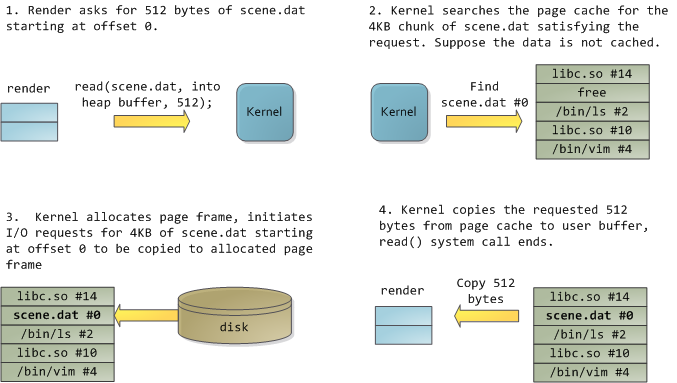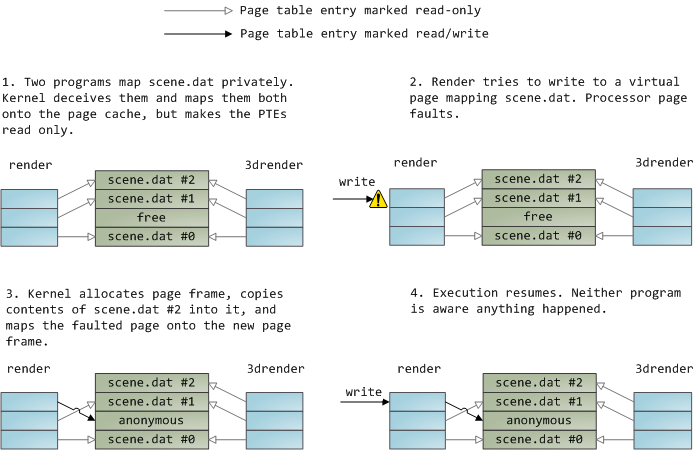Page Cache, the Affair Between Memory and Files
Previously we looked at how the kernel manages virtual memory for a user process, but files and I/O were left out. This post covers the important and often misunderstood relationship between files and memory and its consequences for performance.
Two serious problems must be solved by the OS when it comes to files. The first one is the mind-blowing slowness of hard drives, and disk seeks in particular, relative to memory. The second is the need to load file contents in physical memory once and share the contents among programs. If you use Process Explorer to poke at Windows processes, you’ll see there are ~15MB worth of common DLLs loaded in every process. My Windows box right now is running 100 processes, so without sharing I’d be using up to ~1.5 GB of physical RAM just for common DLLs. No good. Likewise, nearly all Linux programs need ld.so and libc, plus other common libraries.
Happily, both problems can be dealt with in one shot: the page cache, where the kernel stores page-sized chunks of files. To illustrate the page cache, I’ll conjure a Linux program named render, which opens file scene.dat and reads it 512 bytes at a time, storing the file contents into a heap-allocated block. The first read goes like this:

After 12KB have been read, render‘s heap and the relevant page frames look thus:

This looks innocent enough, but there’s a lot going on. First, even though this program uses regular read calls, three 4KB page frames are now in the page cache storing part of scene.dat. People are sometimes surprised by this, but all regular file I/O happens through the page cache. In x86 Linux, the kernel thinks of a file as a sequence of 4KB chunks. If you read a single byte from a file, the whole 4KB chunk containing the byte you asked for is read from disk and placed into the page cache. This makes sense because sustained disk throughput is pretty good and programs normally read more than just a few bytes from a file region. The page cache knows the position of each 4KB chunk within the file, depicted above as #0, #1, etc. Windows uses 256KB views analogous to pages in the Linux page cache.
Sadly, in a regular file read the kernel must copy the contents of the page cache into a user buffer, which not only takes cpu time and hurts the cpu caches, but also wastes physical memory with duplicate data. As per the diagram above, the scene.dat contents are stored twice, and each instance of the program would store the contents an additional time. We’ve mitigated the disk latency problem but failed miserably at everything else. Memory-mapped files are the way out of this madness:

When you use file mapping, the kernel maps your program’s virtual pages directly onto the page cache. This can deliver a significant performance boost: Windows System Programming reports run time improvements of 30% and up relative to regular file reads, while similar figures are reported for Linux and Solaris in Advanced Programming in the Unix Environment. You might also save large amounts of physical memory, depending on the nature of your application.
As always with performance, measurement is everything, but memory mapping earns its keep in a programmer’s toolbox. The API is pretty nice too, it allows you to access a file as bytes in memory and does not require your soul and code readability in exchange for its benefits. Mind your address space and experiment with mmap in Unix-like systems, CreateFileMapping in Windows, or the many wrappers available in high level languages. When you map a file its contents are not brought into memory all at once, but rather on demand via page faults. The fault handler maps your virtual pages onto the page cache after obtaining a page frame with the needed file contents. This involves disk I/O if the contents weren’t cached to begin with.
Now for a pop quiz. Imagine that the last instance of our render program exits. Would the pages storing scene.dat in the page cache be freed immediately? People often think so, but that would be a bad idea. When you think about it, it is very common for us to create a file in one program, exit, then use the file in a second program. The page cache must handle that case. When you think more about it, why should the kernel ever get rid of page cache contents? Remember that disk is 5 orders of magnitude slower than RAM, hence a page cache hit is a huge win. So long as there’s enough free physical memory, the cache should be kept full. It is therefore not dependent on a particular process, but rather it’s a system-wide resource. If you run render a week from now and scene.dat is still cached, bonus! This is why the kernel cache size climbs steadily until it hits a ceiling. It’s not because the OS is garbage and hogs your RAM, it’s actually good behavior because in a way free physical memory is a waste. Better use as much of the stuff for caching as possible.
Due to the page cache architecture, when a program calls write() bytes are simply copied to the page cache and the page is marked dirty. Disk I/O normally does not happen immediately, thus your program doesn’t block waiting for the disk. On the downside, if the computer crashes your writes will never make it, hence critical files like database transaction logs must be fsync()ed (though one must still worry about drive controller caches, oy!). Reads, on the other hand, normally block your program until the data is available. Kernels employ eager loading to mitigate this problem, an example of which is read ahead where the kernel preloads a few pages into the page cache in anticipation of your reads. You can help the kernel tune its eager loading behavior by providing hints on whether you plan to read a file sequentially or randomly (see madvise(), readahead(), Windows cache hints). Linux does read-ahead for memory-mapped files, but I’m not sure about Windows. Finally, it’s possible to bypass the page cache using O_DIRECT in Linux or NO_BUFFERING in Windows, something database software often does.
A file mapping may be private or shared. This refers only to updates made to the contents in memory: in a private mapping the updates are not committed to disk or made visible to other processes, whereas in a shared mapping they are. Kernels use the copy on write mechanism, enabled by page table entries, to implement private mappings. In the example below, both render and another program called render3d (am I creative or what?) have mapped scene.dat privately. Render then writes to its virtual memory area that maps the file:

The read-only page table entries shown above do not mean the mapping is read only, they’re merely a kernel trick to share physical memory until the last possible moment. You can see how ‘private’ is a bit of a misnomer until you remember it only applies to updates. A consequence of this design is that a virtual page that maps a file privately sees changes done to the file by other programs as long as the page has only been read from. Once copy-on-write is done, changes by others are no longer seen. This behavior is not guaranteed by the kernel, but it’s what you get in x86 and makes sense from an API perspective. By contrast, a shared mapping is simply mapped onto the page cache and that’s it. Updates are visible to other processes and end up in the disk. Finally, if the mapping above were read-only, page faults would trigger a segmentation fault instead of copy on write.
Dynamically loaded libraries are brought into your program’s address space via file mapping. There’s nothing magical about it, it’s the same private file mapping available to you via regular APIs. Below is an example showing part of the address spaces from two running instances of the file-mapping render program, along with physical memory, to tie together many of the concepts we’ve seen.

This concludes our 3-part series on memory fundamentals. I hope the series was useful and provided you with a good mental model of these OS topics. Next week there’s one more post on memory usage figures, and then it’s time for a change of air. Maybe some Web 2.0 gossip or something. ![]()
Page Cache, the Affair Between Memory and Files的更多相关文章
- 工作于内存和文件之间的页缓存, Page Cache, the Affair Between Memory and Files
原文作者:Gustavo Duarte 原文地址:http://duartes.org/gustavo/blog/post/what-your-computer-does-while-you-wait ...
- Page Cache, the Affair Between Memory and Files.页面缓存-内存与文件的那些事
原文标题:Page Cache, the Affair Between Memory and Files 原文地址:http://duartes.org/gustavo/blog/ [注:本人水平有限 ...
- Page Cache buffer Cache
https://www.thomas-krenn.com/en/wiki/Linux_Page_Cache_Basics References Jump up ↑ The Buffer Cache ( ...
- (转载)ASP.NET Quiz Answers: Does Page.Cache leak memory?
原文地址:http://blogs.msdn.com/b/tess/archive/2006/08/11/695268.aspx "We use Page.Cache to store te ...
- 【转】Linux Page Cache的工作原理
1 .前言 自从诞生以来,Linux 就被不断完善和普及,目前它已经成为主流通用操作系统之一,使用得非常广泛,它与Windows.UNIX 一起占据了操作系统领域几乎所有的市场份额.特别是在高性能计算 ...
- page cache 与free
我们经常用free查看服务器的内存使用情况,而free中的输出却有些让人困惑,如下: 先看看各个数字的意义以及如何计算得到: free命令输出的第二行(Mem):这行分别显示了物理内存的总量(tota ...
- Linux中的Buffer Cache和Page Cache echo 3 > /proc/sys/vm/drop_caches Slab内存管理机制 SLUB内存管理机制
Linux中的Buffer Cache和Page Cache echo 3 > /proc/sys/vm/drop_caches Slab内存管理机制 SLUB内存管理机制 http://w ...
- Linux的page cache使用情况/命中率查看和操控
转载自宋宝华:https://blog.csdn.net/21cnbao/article/details/80458173 这里总结几个Linux文件缓存(page cache)使用情况.命中率查看的 ...
- 从free到page cache
Free 我们经常用free查看服务器的内存使用情况,而free中的输出却有些让人困惑,如下: 图1-1 先看看各个数字的意义以及如何计算得到: free命令输出的第二行(Mem):这行分别显示了 ...
随机推荐
- Cocos2d-x 3.0 lua规划 真正的现在Android在响应Home密钥和Back纽带
local listenerKey= cc.EventListenerKeyboard:create() local function onKeyReleaseed(keycode,event) if ...
- JavaScript引用类型之Array数组的拼接方法-concat()和截取方法-slice()
1.concat() 基于当前数组中的所有项创建一个新数组(也就是副本),然后将接收到的参数添加到副本的末尾,最后返回新构建的数组.也就是说,concat()在向数组中追加元素时,不会改变原有数组 ...
- 保护眼睛,绿豆沙颜色的RGB值和HSL值
现在的人尤其是职场中人,每天都得花很长时间对着电脑,对眼睛的伤害很大,其实我们可以对电脑进行一个简单的设置,把窗口背景设置成绿豆沙颜色的,对眼睛的保护很有帮助的. 下面是绿豆沙颜色的RGB值和HSL值 ...
- 【转】CoreData以及MagicalRecord (一)
先粗略的了解下CoreData中的一些核心概念 1. CoreData 的核心概念 先上两幅关键的概念图 (1)NSManagedObjectModel 托管对象模型(MOM)是描述应用程序的数据模型 ...
- SQL类型转换以及自动在前面补0满足10位工号标示法
1,自动在前面补0满足10位工号标示法 SELECT rtrim(ltrim(right(cast('00000000'+rtrim(CAST(数值 as int)) as varchar(20)), ...
- C# 微信公众平台开发(1)-- 服务器配置
题记:最近公司需要开发微信服务号,由本人负责,以前虽然听过微信开发,但并没有认真的去了解,项目开发中,也边看文档边开发,记录自己的项目开发经验: 1.注册帐号--填写服务器配置 在https://mp ...
- trangle
#include<iostream> #include<algorithm> using namespace std; int main() { int a,b,c; whil ...
- Linux命令之修改主机名
ubuntu永久修改主机名 1.查看主机名 在Ubuntu系统中,快速查看主机名有多种方法: 其一,打开一个GNOME终端窗口,在命令提示符中可以看到主机名,主机名通常位于“@”符号后: 其二,在终端 ...
- aJax学习之Ajax工作原理
转自:http://www.cnblogs.com/mingmingruyuedlut/archive/2011/10/18/2216553.html 在写这篇文章之前,曾经写过一篇关于AJAX技术的 ...
- 通过class实例取得类的接口,父类,构造器
interface China { public static final String NATIONAL = "JAPAN"; public static fin ...
